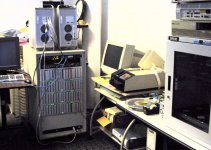
I'm one of the folks who picked up the PDP-11/34 from the NYC craigslist a few weekends ago. After cleaning out the dust and contacts, reseating all the cards and cables, and removing all of the decayed air filters, we have one of the cabinets booting RT-11 from the RK05 drives really well and have restored several of the VT100 terminals. We've written some initial notes on the NYC Resistor blog http://www.nycresistor.com/2014/05/15/pdp-11/ and I'm collecting further notes on my own site http://trmm.net/PDP-11. We haven't powered up the dual cabinet machine, RL02 drives or TU10 tape unit yet and are researching the correct recipes for baking the tapes prior to attempting to read them.

One of our initial goals is to make copies of the various decpacks that were in the lot. It looks like COPY/DEVICE/BINARY RK0: TT: should do it, but both in simh and on the real hardware the NUL characters are not being output. I see that SET LP CTRL will allow the line printer to receive control characters, but there doesn't seem to be an equivalent option for the TT device. As another work around, I can use DUMP/NOASCII/WORDS/TERMINAL RK0:, but this bloats up the data by at least 4x and the terminal link is only 9600 baud so each 2.5MB pack would take nearly two hours. Is there an easy way to enable a raw output mode with COPY, or do I need to write a something that does bit-stuffing or base64 encoding?



